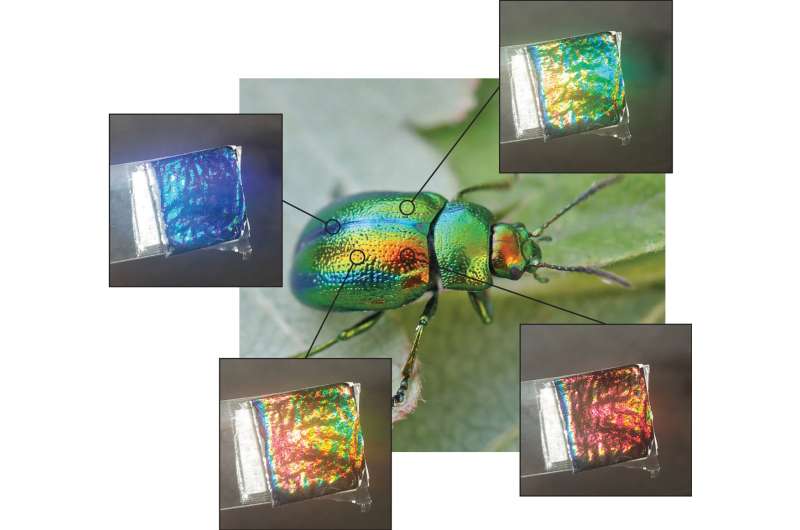This article has been reviewed according to Science X's editorial process and policies. Editors have highlighted the following attributes while ensuring the content's credibility:
fact-checked
trusted source
proofread
Beetles living in the dark teach us how to make sustainable colors

Inspired by beetle cuticles, scientists have developed optical structures that can produce vibrant, iridescent and completely biodegradable colors using chitin—the world's second most abundant organic material.
"Extreme scarcity conditions have enabled natural materials to evolve into some of the most extraordinary materials on Earth, such as incredibly strong spider silk and impact-resistant seashells," said Javier Fernandez, Associate Professor of Singapore University of Technology and Design (SUTD).
Throughout history, scientists have consistently turned to nature for inspiration to solve problems and develop new technologies, from da Vinci's flying machines modeled after birds to efficient swimsuits that mimic shark skin.
A decade ago, Assoc Prof Fernandez proposed to use nature as not only a source of inspiration for materials science, but a blueprint of how natural molecules must be organized to recreate the extraordinary properties of natural materials. "Matching natural molecules with their native organization enables their use without modification, resulting in materials that remain fully integrated into the natural ecological cycles," he added.
Assoc Prof Fernandez's research in bioinspired engineering focuses on chitin. As Earth's second most abundant organic molecule, chitin is renewable and part of every ecological cycle. It is also the material nature uses to produce some of its most exceptional structures, such as an insect's light and stiff wings, a seashell's tough exterior, and a butterfly's remarkable colors. Therefore, controlling it has broad implications in engineering due to its versatility and sustainability.
In an earlier study, Assoc Prof Fernandez and his team found that isolated chitin can aggregate and create strong materials while maintaining its optical function. Their latest study, "Large-scale artificial production of coleoptera cuticle iridescence and its use in conformal biodegradable coatings" built on these results by learning from beetles how to efficiently use chitin to produce color at large scales. They, however, did not learn it from colorful beetles.
While beetles living on plants use complex structures to produce vibrant and iridescent colors for many tasks, from communicating information to confusing predators, some dark-colored species living in concealed/dark environments produce faint color reflections without apparent use for them. It is this mechanism that interests Assoc Prof Fernandez, as it involves simple structures that can be easily implemented in manufacturing processes.
Beetles living in dark environments have their exoskeleton covered by chitin folds, which help them move easily through mud and damp areas. Interestingly, when those folds combine with the melanin-rich background responsible for their dark color, their cuticles become iridescent, reflecting different colors when exposed to light.
The researchers found that the periodicity of the folds is not naturally optimized to produce color. However, the team could optimize it artificially and was able to produce, with this simplified mechanism, iridescent chitinous colors comparable to those generated by the complex structures of the brightly colored beetles living on leaves.
This simple construction allowed the team, in just one year, to upscale the production of color from microscopic samples used as proof of concept, to A4-sized films, the largest example of structural color produced with its native molecule to date. These results are not just significant in theory but also technologically relevant.
"Since chitin is FDA-approved for medical and cosmetics use, it provides a health and environment-friendly alternative to synthetic materials used in those applications," explained Assoc Prof Fernandez. Adding to their past results on using chitin to produce consumables locally, the team expects to incorporate color structurally in general manufacturing, removing the need to include artificial dyes.
Moving forward, Assoc Prof Fernandez views bioinspired manufacturing as a mutually beneficial synergy between biology and technology, enabling the technological use of new materials informed by biological designs and helping researchers create controlled models to understand biological systems better.
The research is published in the journal Advanced Engineering Materials.
More information: Akshayakumar Kompa et al, Large‐Scale Artificial Production of Coleoptera Cuticle Iridescence and Its Use in Conformal Biodegradable Coatings, Advanced Engineering Materials (2024). DOI: 10.1002/adem.202301713
Provided by Singapore University of Technology and Design





















